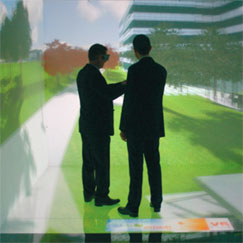
Exploring the ActiveCube at the new NVision Centre at the University of Northampton
A school assembly hall that once housed rows of children is now dominated by the strange sight of a large cube with various appendages and a smaller cube perched on top. Welcome to the NVision Centre, billed as the most impressive virtual reality (VR) suite anywhere in Europe, where a new visualisation installation has been squeezed into the old hall at the University of Northampton. It’s all part of a scheme to enhance the prospects of businesses in the East Midlands and the surrounding area by offering them hardware and software capabilities that can be hired by the day or the hour.
All forms of business are targeted – engineering firms for communicating design changes; automotive or aerospace companies for visualising parts in situ; training partners to refine workflows of taking machines to pieces; or architects to walkthrough life-sized buildings.
The visualisation technology is rather astounding and way above and beyond what a normal small to medium enterprise (SME) could afford to invest in on its own. Funding has come from the European Regional Development Fund and the East Midlands Development Agency with the aim of having around 500 SMEs use the facilities over the next five years.
The site offers an array of technology that means CAD data can be digitally worked with on a number of levels. A model shown in life-size scale can help assess styling or spot any potential manufacturing problems much earlier on in the design process. Via an internet link a design firm can also communicate its design with its customers or design offices elsewhere in the world, or even use the giant 3D wall for a product launch to give its marketing the boost it needs.
“If you’ve got something that’s complicated in some way, or in multiple locations (even if you’re multinational), being able to do that in a virtual prototype allows that communication and understanding to be done a lot faster in the design and manufacture process,” confirms David Cockburn-Price, managing director, Virtalis, the leading VR and visualisation company behind the project.
Virtalis has installed a huge six-by-four metre ActiveWall X4; a unique five-sided ActiveCube (the only one in the country) sat on top allowing for the cube’s floor to be projected from the mother-cube below, and a smaller ActiveWall in the building’s basement.
the visualisation technology is rather astounding and way above and beyond what a normal small to medium enterprise (SME) could afford to invest in on its own
The ActiveCube allows you to step inside a model or room and to examine an object or situation as if you were actually there. In reality you are standing in a large box, where the model is projected onto all four walls, the ceiling and floor. Everything you see is controlled by sensors on special 3D glasses, and you have the ability to interact with models or objects using a handheld ‘wand’.
Interacting with a virtual model is more useful and detailed than you would first imagine. For instance, users have the possibility of walking down the aisle of an aircraft and viewing close up how different seat fabric patterns change the feel of the cabin. Plates or wine glasses can be picked up from a table and the patterns inspected as you would picking up a real item.
Andrew continues to explain the power behind the ActiveWall, a huge wall capable of displaying interactive 3D models in 6.2 mega pixels of detail to a large number of people. It is built around four three-chip DLP Christie cinema projectors and the unique Quadro Plex setup, a multi-GPU (Graphics Processing Unit) visualisation solution from Nvidia.
“This is the first dual Quadro Plex system where there are two Quadro Plex systems that sync off the same computer,” he explains. “What that means is there is one computer with four graphics cards in, but there is a special mode that Nvidia calls Mosaic which allows the four graphics cards to appear as one graphics card to Windows, so you can issue one set of commands and broadcast them split between the appropriate cards for you.”
The technical specs are quite mind boggling, but what is more surprising is that despite the 48,000 lumens of light being emitted from the projectors (a home cinema projector usually emits around 1,000 lumens), the key to the colour richness and high gradients of contrast on the screen is in fact the screen itself. Shipped all the way from the USA, a full set of windows and a special gantry were required to install the 600kg ‘simulation grade’ screen.
In addition to the hardware Virtalis also provides access to a huge range of software and the skills to take a CAD model – whatever it has been built in – and into the VR environment.
Costs top out at around £2,450 for exclusive hire of the ActiveWall and ActiveCube with someone on-hand to run the systems for the day. East Midlands SMEs can have all this for £1,600 thanks to a development fund discount.
This type of money might seem a large outlay, but when compared to the costs of commissioning physical prototypes and the time that can take, digital prototyping at life size scales offers much to the product development process.
It’s an impressive setup, all the equipment is cutting edge and powered by the best available hardware, but a project such as this should be valued on its practical benefits – in this case small businesses getting the chance to use such technology usually reserved for large organisations, and as a result making them more competitive.
www.northampton.ac.uk/nvision / www.virtalis.com

Stephen Holmes reports from a new Virtual Reality Suite at the University of Northampton






